2016 Peugeot Expert VU ECO mode
[x] Cancel search: ECO modePage 220 of 520

218
Stop & StartGoing into engine
STOP mode
If your vehicle has a manual gearbox, its
speed must be below 12 mph (20 km/h) or
stationary (depending on engine); the "
eCo"
i
ndicator lamp comes on in the instrument
panel and the engine goes into standby
automatically when you place the gear lever in
neutral and you release the clutch pedal.
For your comfort, during parking
manoeuvres, S
t
o
P m
ode is not
available for a few seconds after
coming out of reverse gear.
Stop & Start does not affect the
functionality of the vehicle, such as for
example, braking, power steering...
A slight delay between the vehicle
stopping and the engine cutting out may
be noticed. If your vehicle is fitted with
Stop & Start, a time counter
calculates the time spent in
S
t
o
P m
ode during a journey.
It resets to zero every time the ignition is
switched on.
Stop & Start time counter
the Stop & Start system puts the engine
temporarily into standby - St oP m ode -
during stops in the traffic (red lights, traffic
jams, or other...).
t
h
e engine restarts
automatically
- S
tA
R
t
mode - as soon as
you want to move off.
t
h
e restart takes place
instantly, quickly and silently.
Per fect for urban use, the Stop & Start system
reduces fuel consumption and exhaust
emissions as well as the noise level when
stationary.
If your vehicle has an automatic gearbox
and the vehicle is stationary, the "
eCo"
i
ndicator lamp comes on and the engine goes
into standby automatically when you press
the brake pedal or place the gear selector in
position N .
If your vehicle has an electronic gearbox and
the vehicle's speed is below 5 mph (8km/h),
the "
eCo" i
ndicator lamp comes on and the
engine goes into standby automatically when
you press the brake pedal or place the gear
selector in position N . (minutes / seconds or hours / minutes)
Never refuel with the engine in S
t
o
P
m
ode; you must switch off the ignition
with the button.
Driving
Page 221 of 520
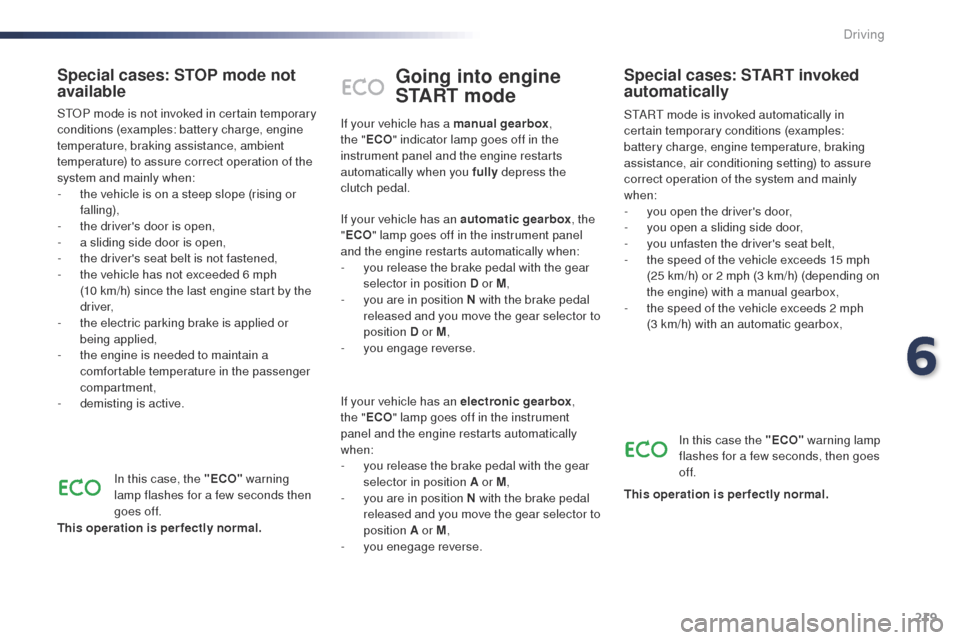
219
Going into engine
START mode
StARt mode is invoked automatically in
certain temporary conditions (examples:
battery charge, engine temperature, braking
assistance, air conditioning setting) to assure
correct operation of the system and mainly
when:
-
y
ou open the driver's door,
-
y
ou open a sliding side door,
-
y
ou unfasten the driver's seat belt,
-
t
he speed of the vehicle exceeds 15 mph
(25 km/h) or 2 mph (3 km/h) (depending on
the engine) with a manual gearbox,
-
t
he speed of the vehicle exceeds 2 mph
(3 km/h) with an automatic gearbox,
Special cases: START invoked
automatically
In this case the "ECO" warning lamp
flashes for a few seconds, then goes
of f.
This operation is perfectly normal.
If your vehicle has a manual gearbox
,
the " ECO " indicator lamp goes off in the
instrument panel and the engine restarts
automatically when you fully depress the
clutch pedal.
If your vehicle has an automatic gearbox , the
" ECO " lamp goes off in the instrument panel
and the engine restarts automatically when:
-
y
ou release the brake pedal with the gear
selector in position D or M ,
-
y
ou are in position N with the brake pedal
released and you move the gear selector to
position D or M ,
-
y
ou engage reverse.
If your vehicle has an electronic gearbox ,
the " ECO " lamp goes off in the instrument
panel and the engine restarts automatically
when:
-
y
ou release the brake pedal with the gear
selector in position A or M ,
-
y
ou are in position N with the brake pedal
released and you move the gear selector to
position A or M ,
-
y
ou enegage reverse.
Special cases: STOP mode not
available
StoP mode is not invoked in certain temporary
conditions (examples: battery charge, engine
temperature, braking assistance, ambient
temperature) to assure correct operation of the
system and mainly when:
-
t
he vehicle is on a steep slope (rising or
falling),
-
t
he driver's door is open,
-
a s
liding side door is open,
-
t
he driver's seat belt is not fastened,
-
t
he vehicle has not exceeded 6 mph
(10 km/h) since the last engine start by the
driver,
-
t
he electric parking brake is applied or
being applied,
-
t
he engine is needed to maintain a
comfortable temperature in the passenger
compartment,
-
d
emisting is active.In this case, the "ECO" warning
lamp flashes for a few seconds then
goes
off.
This operation is perfectly normal.
6
Driving
Page 222 of 520
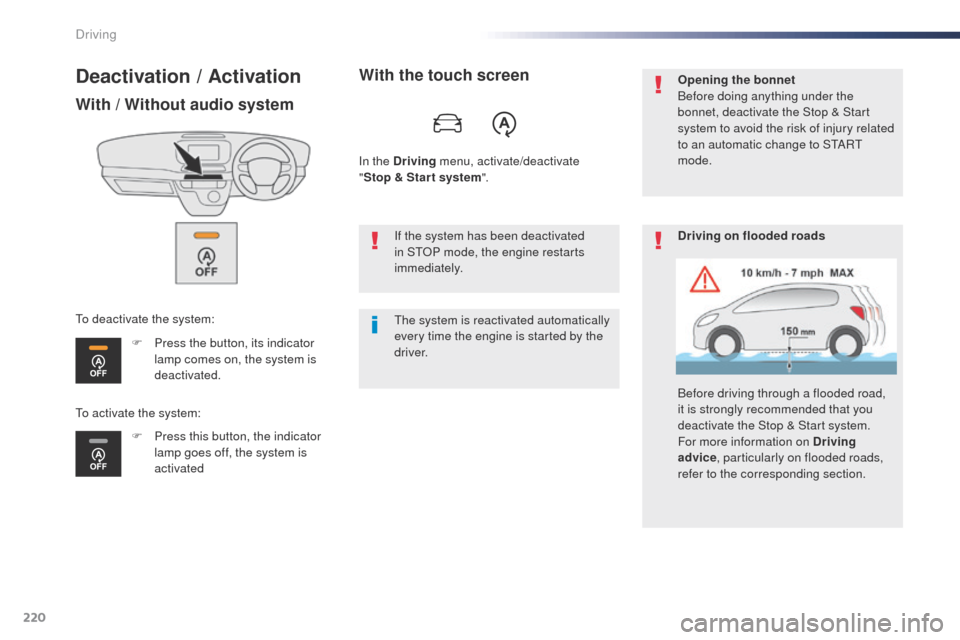
220
Deactivation / Activation
With / Without audio system
F Press the button, its indicator lamp comes on, the system is
deactivated.
F
P
ress this button, the indicator
lamp goes off, the system is
activated
to d
eactivate the system:
With the touch screen
In the Driving
menu, activate/deactivate
" Stop & Star t system ".
th
e system is reactivated automatically
every time the engine is started by the
driver. If the system has been deactivated
in S
t
o
P m
ode, the engine restarts
immediately. Opening the bonnet
Before doing anything under the
bonnet, deactivate the Stop & Start
system to avoid the risk of injury related
to an automatic change to S
tA
R
t
mode.
Driving on flooded roads
Before driving through a flooded road,
it is strongly recommended that you
deactivate the Stop & Start system.
For more information on Driving
advice , particularly on flooded roads,
refer to the corresponding section.
to a
ctivate the system:
Driving
Page 229 of 520
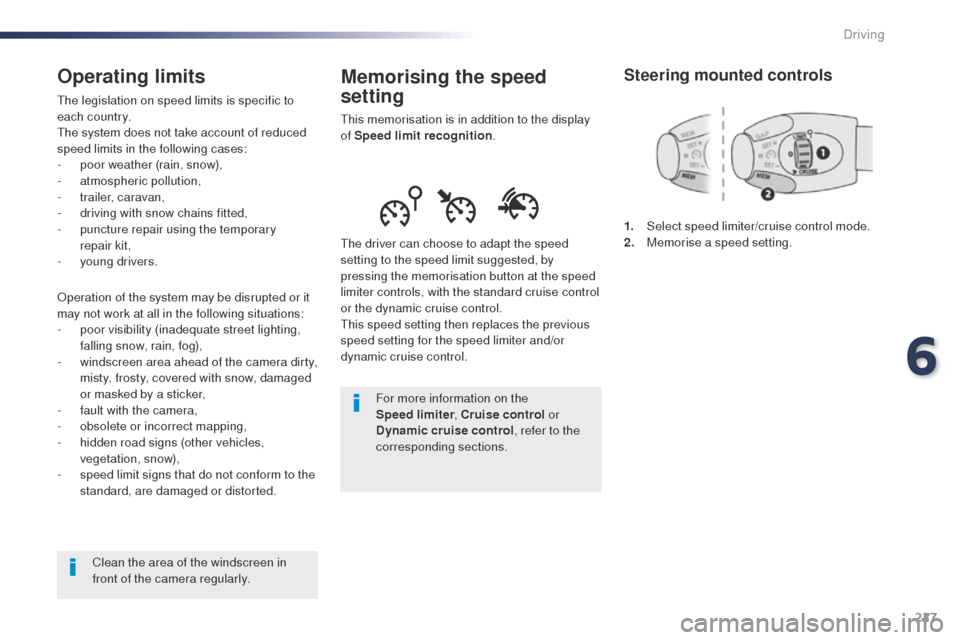
227
Memorising the speed
setting
this memorisation is in addition to the display
of Speed limit recognition .
th
e driver can choose to adapt the speed
setting to the speed limit suggested, by
pressing the memorisation button at the speed
limiter controls, with the standard cruise control
or the dynamic cruise control.
th
is speed setting then replaces the previous
speed setting for the speed limiter and/or
dynamic cruise control.
For more information on the
Speed limiter , Cruise control or
Dynamic cruise control , refer to the
corresponding sections.
Steering mounted controls
1. Select speed limiter/cruise control mode.
2. M emorise a speed setting.
Operating limits
the legislation on speed limits is specific to
each country.
th
e system does not take account of reduced
speed limits in the following cases:
-
p
oor weather (rain, snow),
-
a
tmospheric pollution,
-
t
railer, caravan,
-
d
riving with snow chains fitted,
-
p
uncture repair using the temporary
repair
kit,
-
y
oung drivers.
op
eration of the system may be disrupted or it
may not work at all in the following situations:
-
p
oor visibility (inadequate street lighting,
falling snow, rain, fog),
-
w
indscreen area ahead of the camera dirty,
misty, frosty, covered with snow, damaged
or masked by a sticker,
-
f
ault with the camera,
-
o
bsolete or incorrect mapping,
-
h
idden road signs (other vehicles,
vegetation, snow),
-
s
peed limit signs that do not conform to the
standard, are damaged or distorted.
Clean the area of the windscreen in
front of the camera regularly.
6
Driving
Page 231 of 520
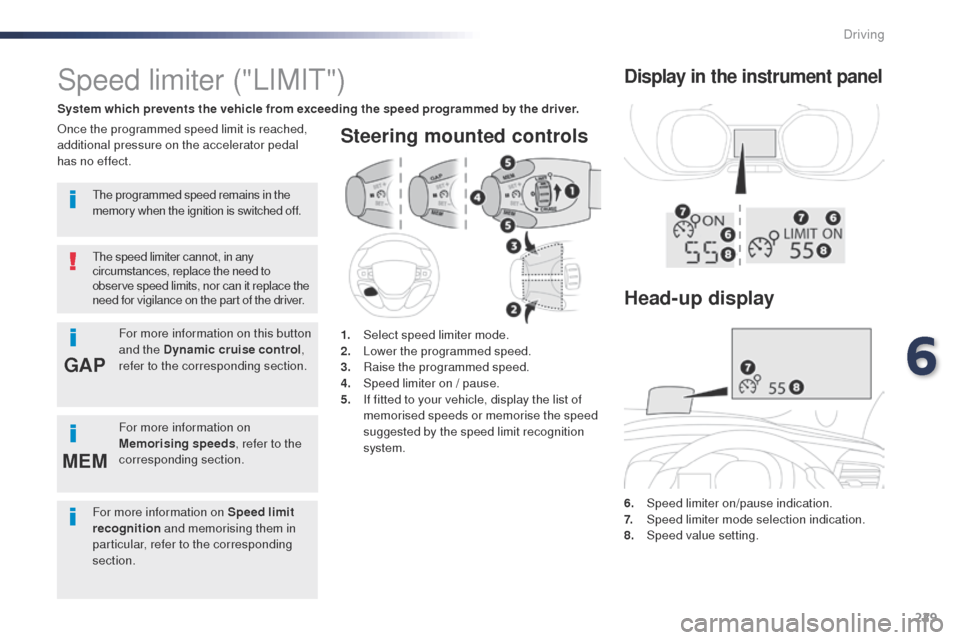
229
GAP
MEM
Steering mounted controls
6. Speed limiter on/pause indication.
7. Spe ed limiter mode selection indication.
8.
Spe
ed value setting.
Speed limiter ("LIMIt")
System which prevents the vehicle from exceeding the speed programmed by the driver.
th
e speed limiter cannot, in any
circumstances, replace the need to
observe speed limits, nor can it replace the
need for vigilance on the part of the driver.
on
ce the programmed speed limit is reached,
additional pressure on the accelerator pedal
has no effect.
1.
Sel
ect speed limiter mode.
2.
L
ower the programmed speed.
3.
Ra
ise the programmed speed.
4.
S
peed limiter on / pause.
5.
I
f fitted to your vehicle, display the list of
memorised speeds or memorise the speed
suggested by the speed limit recognition
system.
Display in the instrument panel
the programmed speed remains in the
memory when the ignition is switched off.
For more information on this button
and the Dynamic cruise control ,
refer to the corresponding section.
For more information on
Memorising speeds , refer to the
corresponding section.
Head-up display
For more information on Speed limit
recognition and memorising them in
particular, refer to the corresponding
section.
6
Driving
Page 234 of 520
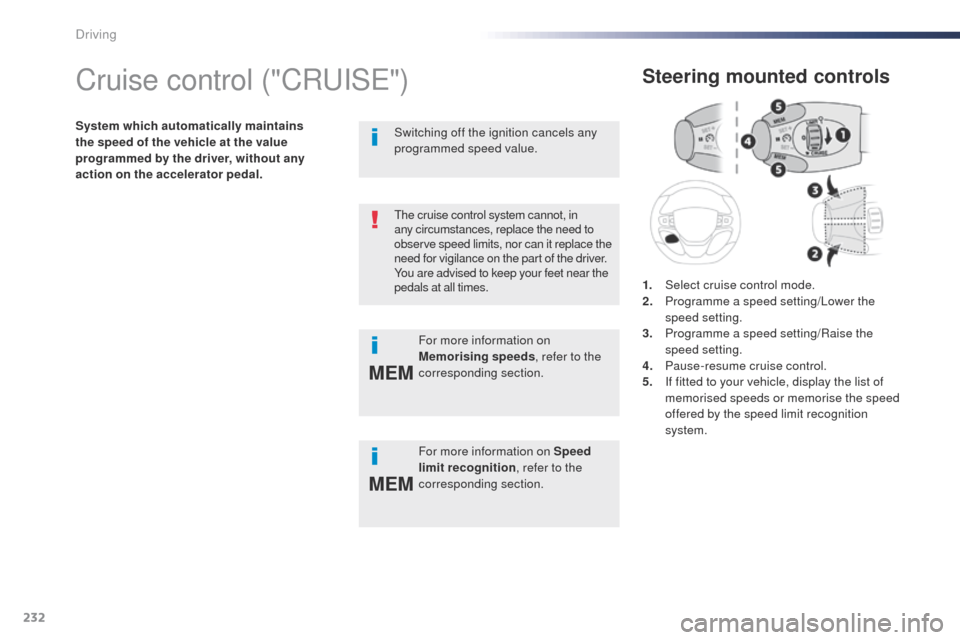
232
MEM
MEM
Cruise control ("CRuISe" )
System which automatically maintains
the speed of the vehicle at the value
programmed by the driver, without any
action on the accelerator pedal.
Steering mounted controls
1. Select cruise control mode.
2. P
rogramme a speed setting/Lower the
speed setting.
3.
P
rogramme a speed setting/Raise the
speed setting.
4.
P
ause-resume cruise control.
5.
I
f fitted to your vehicle, display the list of
memorised speeds or memorise the speed
offered by the speed limit recognition
system.
the cruise control system cannot, in
any circumstances, replace the need to
observe speed limits, nor can it replace the
need for vigilance on the part of the driver.
You are advised to keep your feet near the
pedals at all times.
For more information on Speed
limit recognition , refer to the
corresponding section.
Switching off the ignition cancels any
programmed speed value.
For more information on
Memorising speeds , refer to the
corresponding section.
Driving
Page 235 of 520
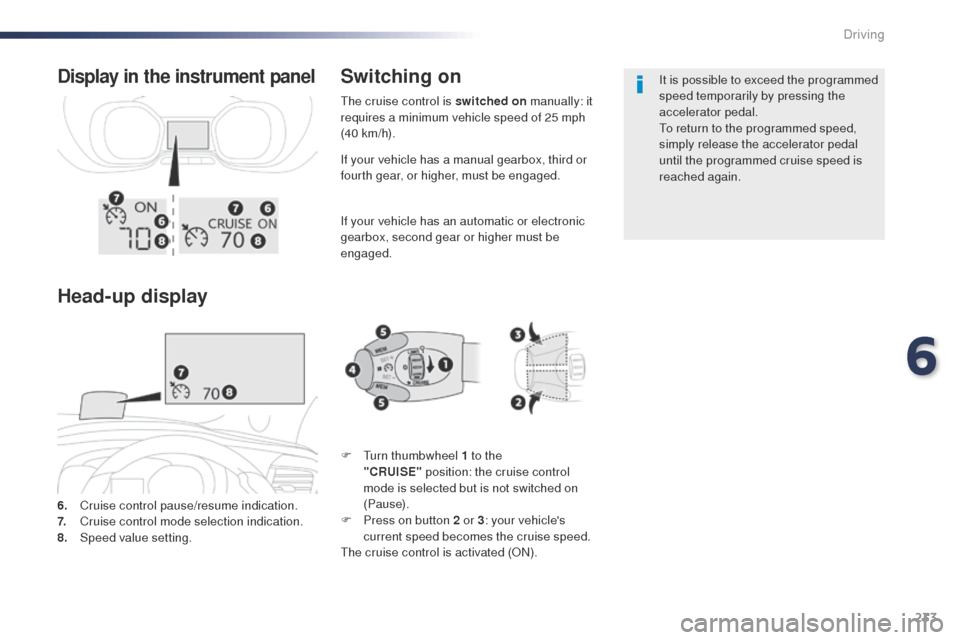
233
If your vehicle has a manual gearbox, third or
fourth gear, or higher, must be engaged.
If your vehicle has an automatic or electronic
gearbox, second gear or higher must be
engaged.
6.
C
ruise control pause/resume indication.
7.
C
ruise control mode selection indication.
8.
Spe
ed value setting.
Display in the instrument panel
Head-up display Switching on
F turn thumbwheel 1 to the
"CRUISE" position: the cruise control
mode is selected but is not switched on
(Pause).
F
P
ress on button 2 or 3 : your vehicle's
current speed becomes the cruise speed.
th
e cruise control is activated (
oN
).It is possible to exceed the programmed
speed temporarily by pressing the
accelerator pedal.
to r
eturn to the programmed speed,
simply release the accelerator pedal
until the programmed cruise speed is
reached again.
th
e cruise control is switched on
manually: it
requires a minimum vehicle speed of 25 mph
(40 km/h).
6
Driving
Page 238 of 520
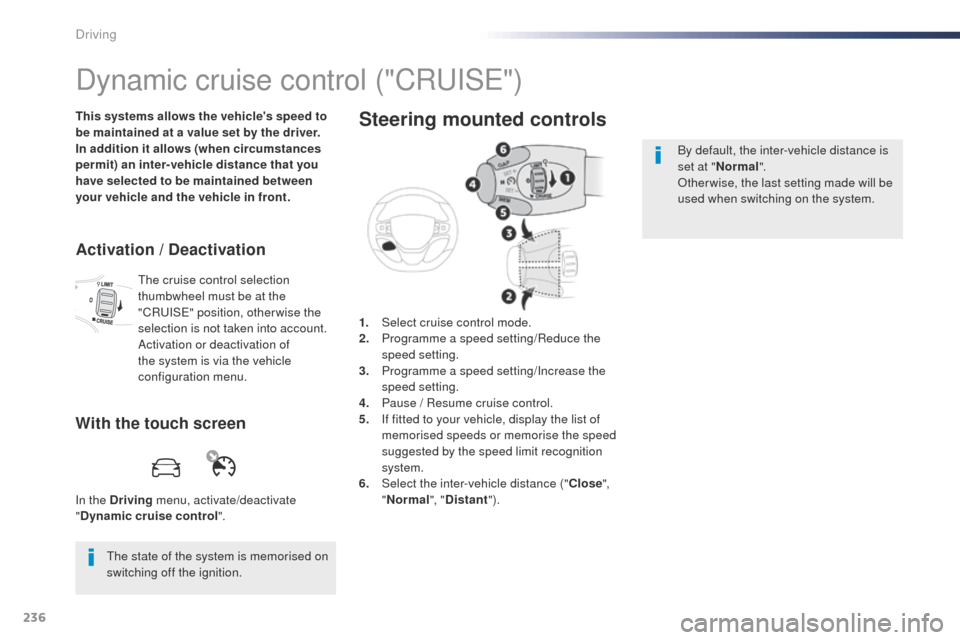
236
Dynamic cruise control ("CRuISe" )
This systems allows the vehicle's speed to
be maintained at a value set by the driver.
In addition it allows (when circumstances
permit) an inter-vehicle distance that you
have selected to be maintained between
your vehicle and the vehicle in front.
In the Driving menu, activate/deactivate
" Dynamic cruise control".
th
e state of the system is memorised on
switching off the ignition.
Activation / Deactivation
the cruise control selection
thumbwheel must be at the
"CR
uI
S
e"
position, otherwise the
selection is not taken into account.
Activation or deactivation of
the system is via the vehicle
configuration menu.
With the touch screen
1. Select cruise control mode.
2. P rogramme a speed setting/Reduce the
speed setting.
3.
P
rogramme a speed setting/Increase the
speed setting.
4.
P
ause / Resume cruise control.
5.
I
f fitted to your vehicle, display the list of
memorised speeds or memorise the speed
suggested by the speed limit recognition
system.
6.
S
elect the inter-vehicle distance (" Close",
" Normal ", "Distant ").
Steering mounted controls
By default, the inter-vehicle distance is
set at "Normal ".
ot
herwise, the last setting made will be
used when switching on the system.
Driving